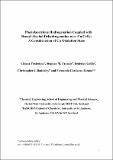Phenylacetylene hydrogenation coupled with benzyl alcohol dehydrogenation over Cu/CeO2 : a consideration of Cu oxidation state
Abstract
We have examined the effect of copper oxidation state in the continuous gas phase coupled phenylacetylene hydrogenation (to styrene) with benzyl alcohol dehydrogenation (to benzaldehyde) over Cu/CeO2. Analysis by H2-TPR, XPS, XRD and STEM-EDX analyses demonstrates the generation of a range of Cu oxidation states (Cu0 (13-77%), Cu+ (13-74%), Cu2+ (0-55%)). The stepwise formation of styrene and ethylbenzene was promoted in the stand-alone phenylacetylene hydrogenation. An increase in Cu0/Cu+ (from H2-TPR and XPS) enhanced H2 chemisorption and styrene TOF, but with low hydrogen utilisation efficiency. The formation of benzaldehyde and toluene was promoted in the stand-alone dehydrogenation of benzyl alcohol, where benzaldehyde selectivity and TOF correlate with the concentration of Cu0. Full hydrogen utilisation, exclusive benzaldehyde/styrene formation and a (3-fold) greater styrene TOF (to attain 100% yield) was achieved in the coupled process, where hydrogenation/dehydrogenation activity correlates with Cu+/Cu0. This opens new directions for sustainable “hydrogen free” hydrogenations over non-noble Cu catalysts.
Citation
Pischetola , C , Francis , S M , Grillo , F , Baddeley , C J & Cárdenas-Lizana , F 2020 , ' Phenylacetylene hydrogenation coupled with benzyl alcohol dehydrogenation over Cu/CeO 2 : a consideration of Cu oxidation state ' , Journal of Catalysis , vol. In press . https://doi.org/10.1016/j.jcat.2020.11.002
Publication
Journal of Catalysis
Status
Peer reviewed
ISSN
0021-9517Type
Journal article
Description
We shall acknowledge the Engineering and Physical Sciences Research Council, University of Heriot-Watt, and CRITICAT Centre for Doctoral Training for financial support [Ph.D. studentship to Chiara Pischetola; Grant EP/L016419/1].Collections
Items in the St Andrews Research Repository are protected by copyright, with all rights reserved, unless otherwise indicated.

